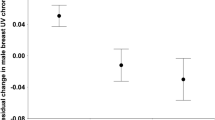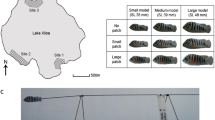Abstract
In breeding plumage, the African male red-shouldered widowbirds (Euplectes axillaris) are black except for red carotenoid-based epaulets ('shoulder patches'), similar to the well-studied American red-winged blackbirds (Agelaius phoeniceus). To experimentally test the signal function of the red epaulets in male red-shouldered widowbirds, we manipulated epaulet colour and size (within natural variation), and observed the effects in two competitive contexts. First, in captivity, unfamiliar males with epaulets of different size or redness were staged in dyadic contests over food. Only epaulet manipulations significantly affected contest outcome; red epaulet males out-competed orange and control males, which in turn dominated blackened (no epaulet) males. Epaulet size manipulations had particularly strong effects; enlarged epaulet males vigorously defeated smaller epaulet males within colour treatments, whereas the independent effect of 'redness' (i.e., within size treatments) was much weaker. Second, in a field experiment, epaulets were manipulated prior to territory establishment. Males with enlarged epaulets acquired territories, whereas most males with blackened or reduced signals failed to obtain territories. Furthermore, among the territorial males, birds with enlarged epaulets defended larger territories and spent less time in boundary signalling, yet they received fewer intrusions from conspecifics. In contrast, epaulet manipulations had no effect on either female visitation rates or subsequent female settlement. These results concur with recent studies and suggest that the carotenoid-based epaulets of red-shouldered widowbirds are status signals, sexually selected through male contest competition for territories.




Similar content being viewed by others
References
Anderson DR, Burham KP (2001) Commentary on models in ecology. Bull Ecol Soc Am 82:160–161
Andersson M (1982) Female choice selects for extreme tail length in a widowbird. Nature 299:818–820
Andersson M (1994) Sexual selection. Princeton University Press, Princeton, N.J.
Andersson S (1992) Female preference for long tails in lekking Jackson's widowbirds: experimental evidence. Anim Behav 43:379–388
Andersson S, Pryke SR, Örnborg J, Lawes MJ, Andersson M (2002) Multiple receivers, multiple ornaments and a trade-off between agonistic and epigamic signaling in a widowbird. Am Nat 160:683–691
Berglund A, Bisazza A, Pilastro A (1996) Armaments and ornaments: An evolutionary explanation of traits of dual utility. Biol J Linn Soc 58:385–399
Bradbury JB, Vehrencamp SL (1998) Principles of animal communication. Sinauer, Sunderland, Mass.
Butcher GS, Rohwer S (1988) The evolution of conspicuous and distinctive coloration for communication in birds. In: Power DP (ed) Current ornithology. Plenum Press, New York, pp 51–108
Burkhardt D (1989) UV vision: a bird's eye view of feathers. J Comp Physiol A 164:787–796
Burley N, Krantzberg G, Radman P (1982) Influence of colour-banding on the conspecific preferences of zebra finches. Anim Behav 30:444–455
Dufour KW, Weatherhead PJ (1998) Bilateral symmetry and social dominance in captive male red-winged blackbirds. Behav Ecol Sociobiol 42:71–76
Eckert CG, Weatherhead PJ (1987) Owners, floaters and competitive asymmetries among territorial red-winged blackbirds. Anim Behav 35:1317–1323
Evans MR, Hatchwell BJ (1992) An experimental study of male adornment in the scarlet-tufted malachite sunbird: I. The role of pectoral tufts in territorial defence. Behav Ecol Sociobiol 29:413–419
Fox HM, Vevers G (1960) The nature of animal colours. Macmillan, New York
Friedl TWP, Klump GM (1999) Determinants of male mating success in the red bishop (Euplectes orix). Behav Ecol Sociobiol 46:387–399
Gray DA (1996) Carotenoids and sexual dichromatism in North American passerine birds. Am Nat 148:453–580
Grether GF (1996) Intrasexual competition alone favours a sexually dimorphic ornament in the rubyspot damselfly Hetaerina Americana. Evolution 50:1949–1957
Grether GF, Hudon J, Millie DF (1999) Carotenoid limitation of sexual coloration along an environmental gradient in guppies. Proc R Soc Lond B 266:1317–1322
Hailman JP (1977) Optical signals. Indiana University Press, Bloomington
Hansen AJ, Rohwer S (1986) Coverable badges and resource defence in birds. Anim Behav 34:69–76
Hill GE (1999) Mate choice, male quality, and carotenoid-based plumage colouration. In: Adams NJ, Slotow, RH (eds) Proc Int Ornithol Congr 22:1654–1668
Hudon, J. (1991) Unusual carotenoid use by the Western Tanager (Piranga ludoviciana) and its evolutionary implications. Can J Zool 69:2311-2320
Jackson WM (1988) Can individual differences in history of dominance explain the development of linear dominance hierarchies? Ethology 79:71–78
Järvi T, Bakken M (1984) The function of the variation in the breast stripe of the great tit (Parus major). Anim Behav 32:590–596
Kodric-Brown A (1989) Dietary carotenoids and male mating success in the guppy: an environmental component to female choice. Behav Ecol Sociobiol 25:393–401
Lessells CM, Boag PT (1987) Unrepeatable repeatabilities: a common mistake. Auk 104:116–121
Lozano GA (1994) Carotenoids, parasites, and sexual selection. Oikos 70:309–311
Maynard Smith J, Harper DGC (1988) The evolution of aggression: can selection generate variability. Phil Trans R Soc Lond B 319:557–570
Metz KJ, Weatherhead PJ (1991) Color bands function as secondary sexual traits in male red-winged blackbirds. Behav Ecol Sociobiol 28:23–27
Metz KJ, Weatherhead PJ (1992) Seeing red: uncovering coverable badges in red-winged blackbirds. Anim Behav 43:223–229
Møller AP, Biard C, Blount JD, Houston DC, Ninni P, Saino N, Surai PF (2000) Carotenoid-dependent signals: indicators of foraging efficiency, immunocompetence or detoxification ability? Avian Poult Biol Rev 11:137–159
Odum EP, Kuenzler EJ (1955) Measurement of territory and home range size in birds. Auk 72:128–137
Olson VA, Owens IPF (1998) Costly sexual signals: are carotenoids rare, risky or required? Trends Ecol Evol 13:510–514
Orians GH, Beletsky LD (1997) Red-winged blackbirds: decision-making and reproductive success. University of Chicago Press, Chicago
Peek FW (1972) An experimental study of the territorial function of vocal and visual display in the male red-winged blackbird (Agelaius phoenicus). Anim Behav 20:112–118
Pryke SR, Andersson S (2002) A generalized female bias for long tails in a short-tailed widowbird. Proc R Soc Lond B 279:2141–2146
Pryke SR, Andersson S (2003) Carotenoid-based epaulets reveal male competitive ability: experiments with resident and floater red-shouldered widowbirds. Anim Behav (in press)
Pryke SR, Andersson S, Lawes MJ (2001a) Sexual selection of multiple handicaps in the red-collared widowbird: female choice of tail length but not carotenoid display. Evolution 55:1452–1463
Pryke SR, Lawes MJ, Andersson S (2001b) Agonistic carotenoid signalling in male red-collared widowbirds: aggression related to the colour signal of both territory owner and model intruder. Anim Behav 62:695–704
Pryke SR, Andersson S, Lawes MJ, Piper SE (2002) Carotenoid status signaling in captive and wild red-collared widowbirds: independent effects of badge size and color. Behav Ecol 13:622–631
Rohwer S (1982) The evolution of reliable and unreliable badges of fighting ability. Am Zool 22:531–546
Røskaft E, Rohwer S (1987) An experimental study of the function of the red epaulettes and black body colour of male red-winged blackbirds. Anim Behav 48:105–111
Savalli UM (1994) Mate choice in the yellow-shouldered widowbird—correlates of male attractiveness. Behav Ecol Sociobiol 35:227–234
Searcy WA (1979a) Female choice of mates: A general model for birds and its application to red-winged blackbirds. Am Nat 114:77–100
Searcy WA (1979b) Morphological correlates of dominance in captive male red-winged blackbirds. Condor 81:417–420
Searcy WA, Yasukawa, K (1995). Polygyny and sexual selection in redwinged blackbirds. Princeton University Press, Princeton, N.J.
Senar JC (1999) Plumage colouration as a signal of social status. In: Adams NJ, Slotow, RH (eds) Proc Int Ornithol Congr 22:1669–1686
Smith DG (1972) The role of the epaulettes in the red-winged blackbird (Agelaius phoeniceus) social system. Behaviour 41:251–268
Smith JNM, Arcese P (1989) How fit are floaters? Consequences of alternate territorial behaviors in a non-migratory sparrow. Am Nat 133:830–845
Studd MV, Robertson RJ (1985) Evidence for reliable badges of status in territorial yellow warblers (Dendroica petechia ). Anim Behav 33:1102–1112
Acknowledgements
Thanks to the owners and managers of Tschonga Farm for allowing us to work on their land, and to Malte Andersson and two anonymous referees who provided helpful comments on the manuscript. Permission to collect, house (permit no. 28562/2001) and work with wild red-shouldered widowbirds (permit no. 28561/2001) was granted by the KwaZulu-Natal Wildlife Services, and all experimental work was approved by the University of Natal's Animal Ethics Committee (reference no. AE/01/10). Funding was provided by the Swedish Science Council (to S.A.) and an academic exchange program from the Swedish STINT foundation (to S.P.)
Author information
Authors and Affiliations
Corresponding author
Additional information
Communicated by M. Elgar
Rights and permissions
About this article
Cite this article
Pryke, S.R., Andersson, S. Carotenoid-based status signalling in red-shouldered widowbirds (Euplectes axillaris): epaulet size and redness affect captive and territorial competition. Behav Ecol Sociobiol 53, 393–401 (2003). https://doi.org/10.1007/s00265-003-0587-2
Received:
Revised:
Accepted:
Published:
Issue Date:
DOI: https://doi.org/10.1007/s00265-003-0587-2




